Welcome to the Janison Insights help portal
Author Tests
A test blueprint is a template you can develop, and then use for creating future tests quickly and efficiently. The tests you create from the blueprint are called ‘blueprinted tests’ and inherit the settings configured in the blueprint.
The Janison Insights blueprint autofill tool uses a powerful matching engine to automatically add questions to the test which meet the specifications you have configured in the blueprint. For example, the number of questions you want added, the question types and the specified tags.

Tip
Test blueprints are sometimes referred to as ‘test plans’ and blueprinted tests as ‘planned tests’.
There is some setting up in the system which needs to be completed before you will be able to create blueprints.
Important
These settings can only be accessed by an Administrator role.


Complete the following:
Tip
When the system autofills blueprinted tests, it will only add items matching the workflow states selected here. For example, if you don’t select ‘retired’, the system won’t add any items in the workflow state of retired to the blueprinted test.

Role permissions will need to be configured to allow the necessary roles to create the blueprint questions and tests.
To do this:




There are two roles to update:
Enable the Blueprint Component and Blueprint Component Open Modules areas.

Enable Export Blueprint Details to allow the export as a report. Enable Get Blueprint Details, Get Blueprint Pnps and Save Blueprint Details.

There are a couple of pre-requisite setup steps to complete before you can begin creating your blueprint.
The first thing we need to do is create tag types with attached tags in order to define the knowledge areas within your test. These are then used to tag questions so they can be characterised into the different knowledge areas. For example, for a Small Animal Medicine test, you may set a tag type of ‘knowledge category’ with tags of ‘anatomy’, ‘medication’ ‘diagnosis’ and ‘treatment’.
Tip
Broadly speaking, tags are linked keywords that are used for categorising items in Janison Insights. Tag types are used to categorise tags into collections.
The system uses modules to categorise topics or knowledge areas. You will need to select the tag types that are relevant to your module in order to be able to use them in that module.
To do this:




The added tag type will display below. Repeat for all tag types you want to add to the module.
Tip
This is the content laying inside tip box

Once you have completed the setting up process, you are ready to create a test blueprint.
Important
The item test sections in the blueprint play a critical role in the blueprinting process.
Blueprints are created and managed by selecting Author from the Menu, then selecting Tests and Surveys.

To create a test blueprint:

Complete the following:

When you save the test blueprint, it displays with the details and several expandable sections for additional settings and options. See the next section, Additional test settings and options for more information.

Once you have created a test blueprint, there are some additional settings you can configure, along with other various options for the test. There are two ways to access these:
In this section, you can set the number of attempts candidates are allowed for the test, as well as the questions they will be able to reattempt and the feedback they will receive before resitting.
Settings in this section are optional.
Important
These settings do not apply to paper-based tests.
To configure these settings:

Complete the following:

In this section, you can set the length of time candidates have to sit the test. If a time is entered here, the candidates will have only that specified time to complete the test and they will see a timer displaying the remaining time throughout the test.
Settings in this section are optional.
To configure these settings:
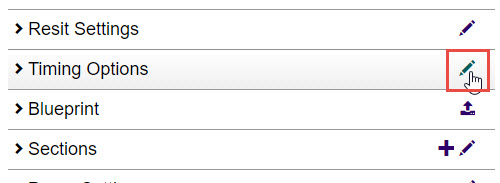

Only question test sections have the blueprint section, from here you can configure the components which determine the questions the system will add to the blueprinted test during the autofill process.
When you first open the section, it won’t contain any components, but you will see the tag types you set at the module level. In this example it’s SAM – Knowledge category

Components get added at a test section level. Once set in the test sections, you can come back to this screen and add the components.
To do this:



In the following blueprint example, we are saying that we want the autofill process to do the following:
All questions will be in English and be worth one mark each.

We can also see from this image that the status for the ‘anatomy’ component has a status of a thumbs up. There are five questions available in the module which match this tag type, so the system will be able to select two of these to add to the blueprinted test.

The remaining components all show a status of a red warning sign. This is because there are not enough questions for the component requirement to be met.

To learn more about the various types of sections, see the Test section types section.
Important
You must create all question sections via these instructions. If you create these via Author > Test Sections, they won’t be visible from within the blueprint and won’t be able to be added.
To do this:


Complete the following:
Select a Navigation Type as follows:
| Navigation type | Description |
|---|---|
| Linear | Candidates must answer the questions in order and cannot skip ahead without answering the current question. |
| Nonlinear | Candidates can skip a question to answer the next question. They can go back and change their answers. |

When you save the test section, it displays with the details and several expandable sections for additional settings and options. The layout of the different sections differs depending on the type created.
Question test sections contain the additional expandable section Blueprint, which is where components are set. This is not found on the other test section types.

You can also add existing sections (all except question test sections) to the blueprint.

Sections already existing in the blueprint will display above the search bar. They also display in the search section, but show as inactive. Sections available to add to the test blueprint are displayed in an active state.

The test section will be added to the list of sections within the test.
While you can add new test sections from within the blueprint, you can also add sections from the Author Menu.
Tip
You should not add question test sections using this method, as they won’t be available for selection in the blueprint.
To learn more about creating new test sections from the Author Menu, see the document on Create a test section.
Now that the test blueprint has been created and you have updated the additional settings, it’s time to create the questions. There are a few ways to create questions to add to your test blueprint.
Important
The test section type you want to add the questions to, will determine how they should be created.
For introduction, instruction, survey and exit test section types, questions can be added from the test section.
Tip
For question test sections, you will need to create the questions from the Author Menu. To learn more, see the From the Author Menu section.
To create questions from a test section:
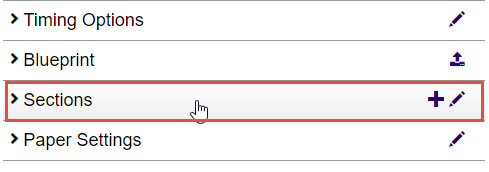


Scroll down to the Add Questions expandable section and select the Create a new Question button.

Select Yes on the notification to leave the page and the New Test Question screen displays.

Tip
The steps to create a question differ depending on the question type you create. To learn more about question types and creating a question, see the Questions section.
To add questions to the bank for question test sections, you need to create questions from the Author Menu.
Tip
For all other test section types, you can create the questions from the test section. To learn more, see the From a test section information.
To create questions from the Author Menu:


Tip
The steps to create a question differ depending on the question type you create. To learn more about question types and creating a question, see the Questions section.
For question test sections, you won’t need to add questions to the section as this will be completed during the autofill process in the blueprinted test.
For other section types, you can add existing question from within the Test Section Details screen.
To do this:

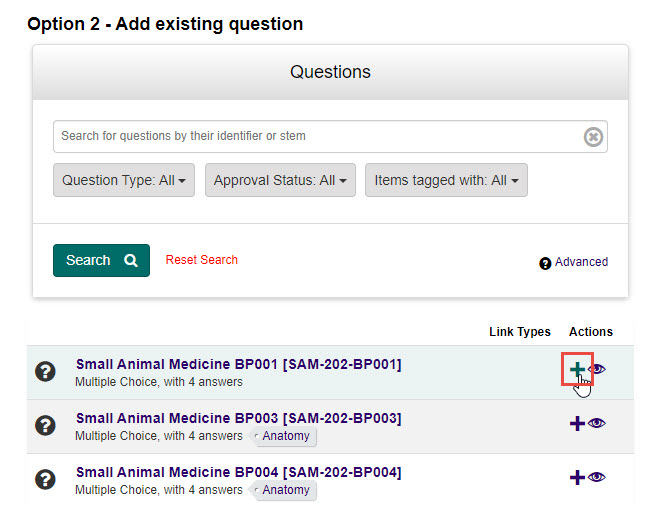
Once you have completed the set-up of your test blueprint, including the creation of sufficient questions to meet the blueprint components you set, you are ready to create one or more blueprinted tests. Once created, these can be added to your assessment events for delivery to candidates.
To create a blueprinted test:


The system creates a blueprinted test with limited ability to make edits.

Tip
The system suffixes the Identifier with -copy. If you make more than one copy, the system suffixes a number, -copy1, -copy2, etc.
The additional settings and options in a blueprinted test are mainly the same as a regular test, with the addition of the Blueprint option.
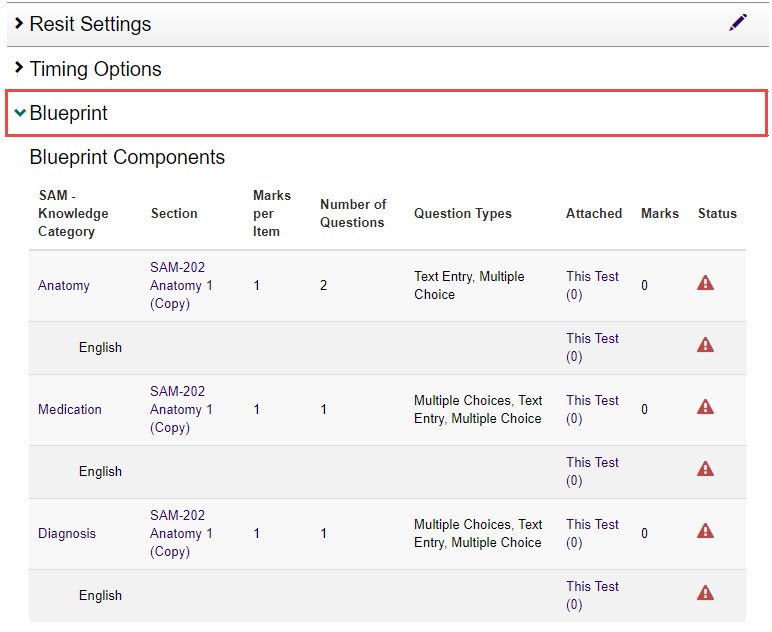
Tip
Initially the Status column under the Blueprint expandable section will show the system needs more questions with the red warning icon. You will need to go into each item section and trigger the autofill feature.
Autofill will randomly select questions from the question bank for the question test section(s). Introduction and instruction sections do not need to be auto filled as they have no blueprint components and already have questions added.
To autofill question test sections from within the blueprinted test:




The system attaches the relevant questions matching the component criteria to the section. You can view the questions by selecting the links in the Attached column. The Status changes from the red warning to a tick to indicate enough questions have been added to the test for each component.
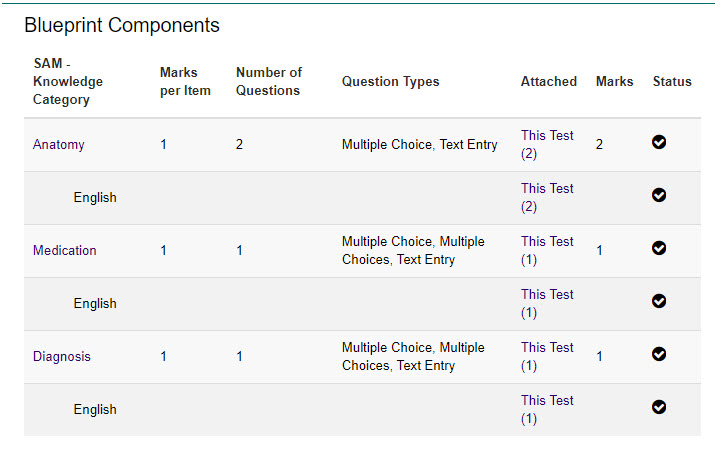
There are several manual configurations you can make to edit the test after the auto filling process has occurred.
This can be done from within the blueprinted test section, by selecting the Edit icon next to the Questions expandable section.

The editing options available are:
| # | Item | Description |
|---|---|---|
| A | Rejected Items | You can reject certain questions by selecting the red Remove question icon in the Actions column. Any rejected questions will be listed here and future autofill processes will not select them. Rejected questions can be restored to the list of available questions by selecting the x. |
| B | Excluded last used range | This field can be used to exclude any question which has been added to a test within a given period of time. Any questions falling within that time period will not be selected by the autofill process. You can set one or both dates. |
| C | Randomisation and optional questions | This field allows you to set randomisation and optional question settings to create variation of questions between candidate attempts. Randomisation occurs at test attempt generation so that when undertaking the test, candidates each receive different question sets. More can be found on this below. |
| D | Weight | This allows you to set a different weight for some questions, for example you may decide a text entry question should be worth two marks, while a multiple-choice question is worth one. |
| E | Anchored | This field allows you to anchor a question for subsequent autofill processes. This means the question will remain as a question for all assessment events featuring this blueprinted test. |
| F | Unrandomized | This field allows you to unrandomise individual questions. For example, even though you may have ‘Randomise Question Order’ chosen in your randomisation settings, you may decide there is a particular question you want to appear first. By checking the Unrandomized checkbox, this question will be shown in the order it appears in the list of questions. |
| G | Actions | There are a couple of different settings in the Actions column.
|
| H | Questions | Used to search for questions. |
| I | Actions | Features the following actions:
|

There are several randomisation and optional question settings available:
| Setting | Description |
|---|---|
| Don’t use optional questions or random selection | The system will add all questions to the test and the candidate will be required to respond to all questions. |
| This section has random question selection | If selected, a second field displays to set the number of random questions which the system will link to the section. |
| This section has subsections that use random question selection | If selected, a field displays under each section where you can set the number of random questions which the system will link to each section. Each row of the blueprint components becomes a subsection in the questions test section. |
| This section has optional questions | If selected, a field displays where you can set the number of optional questions which the system will link to each section. |
| Randomise Question Order | If selected, the system will randomise the question order. |

You can now add the test to an assessment event for candidates to undertake.
1300 857 687 (Australia)
+61 2 6652 9850 (International)
ACN 091 302 975
ABN 35 081 897 494
© 2024 Janison
Janison acknowledges the traditional owners of the land on which we work and meet. We acknowledge the continuous care of the land, animals and waterways. We pay our respects to Elders past, present and emerging.